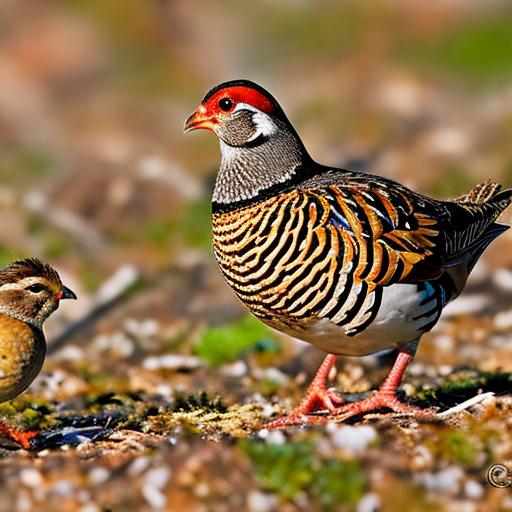Quail and chickens are both popular choices for backyard pets, providing owners with fresh eggs and entertainment. However, there are some key differences between the two that should be considered before deciding to keep them together. Quail are smaller in size compared to chickens, with a more delicate and skittish nature. Chickens, on the other hand, are larger and more social animals. In terms of egg-laying habits, quail are known for their ability to lay eggs consistently throughout the year, while chickens tend to have periods of increased egg production followed by periods of rest.
Key Takeaways
- Keeping quail with chickens can provide benefits such as increased egg production and pest control
- However, potential challenges include aggression and hygiene issues
- Factors to consider before keeping quail with chickens include space requirements and compatibility
- Designing a coop for both quail and chickens requires careful planning and consideration of their unique needs
- Maintaining hygiene and addressing aggression are key to keeping quail and chickens together in harmony.
Benefits of Keeping Quail with Chickens
One of the main benefits of keeping quail with chickens is increased egg production and variety. Quail are prolific layers, often producing an egg a day. By adding quail to your flock, you can enjoy a wider variety of eggs, including small and speckled quail eggs alongside the larger chicken eggs. This can be a fun and unique addition to your breakfast table.
Another benefit is pest control and foraging benefits. Quail are excellent foragers and can help control pests in your backyard. They will eat insects, worms, and other small creatures that may be harmful to your garden or other plants. Chickens also have a natural instinct for foraging, so having both quail and chickens in your backyard can create a dynamic ecosystem where they work together to keep pests at bay.
Additionally, keeping quail with chickens provides socialization and entertainment for both birds. Chickens are social animals that thrive in the company of others. By introducing quail into the flock, you are providing additional companionship for your chickens. Quail, although more skittish by nature, can also benefit from being part of a larger group. Watching the interactions between the two species can be entertaining and enjoyable for the owner.
Potential Challenges of Keeping Quail with Chickens
While there are many benefits to keeping quail with chickens, there are also some potential challenges that should be considered. One challenge is aggression and pecking order issues. Chickens have a well-established pecking order within their flock, and introducing new birds can disrupt this hierarchy. Quail, being smaller and more delicate, may be at a disadvantage when it comes to establishing their place in the pecking order. This can lead to aggression and bullying from the chickens towards the quail.
Another challenge is the different dietary needs and feeding habits of quail and chickens. Quail require a higher protein diet compared to chickens, as they have higher energy needs. They also have different feeding habits, with quail preferring to eat small seeds and insects. This can make it challenging to provide a balanced diet for both species when they are kept together.
Hygiene concerns in a shared coop is another potential challenge. Quail produce smaller droppings compared to chickens, which can make it difficult to maintain cleanliness in a shared coop. Additionally, quail are more prone to respiratory issues, so proper ventilation and cleanliness are crucial to prevent the spread of disease.
Factors to Consider Before Keeping Quail with Chickens
Before deciding to keep quail with chickens, there are several factors that should be considered. First and foremost, it is important to check local regulations and zoning laws regarding the keeping of poultry. Some areas may have restrictions on the number or types of birds that can be kept in residential areas.
Space requirements for both birds should also be taken into account. Quail require less space compared to chickens, but they still need room to move around comfortably. It is recommended to provide at least 1 square foot of space per quail and 4 square feet per chicken in the coop.
Compatibility of breeds and personalities is another important factor to consider. Some chicken breeds may be more aggressive towards quail, while others may be more accepting. It is important to choose chicken breeds that are known to be docile and friendly towards other birds. Additionally, introducing new birds slowly and gradually can help minimize aggression and establish a harmonious flock.
Designing a Chicken Coop for Quail and Chickens
When designing a chicken coop for quail and chickens, there are several tips to keep in mind. First, it is important to provide nesting boxes and perches that are suitable for both species. Quail prefer smaller, enclosed nesting boxes, while chickens require larger, open nesting boxes. Providing separate areas for each species can help ensure that they have their own space to lay eggs and rest.
Separation options for feeding and sleeping should also be considered. Quail and chickens have different feeding habits and dietary needs, so providing separate feeding areas can help prevent competition and ensure that each bird gets the appropriate nutrition. Similarly, providing separate sleeping areas can help minimize aggression and establish a sense of security for both species.
Choosing the Right Size of Coop for Quail and Chickens

The size of the coop is an important factor to consider when keeping quail with chickens. It is recommended to provide at least 1 square foot of space per quail and 4 square feet per chicken in the coop. This will ensure that each bird has enough room to move around comfortably and establish their own territory.
Adjustments may need to be made for mixed flocks, as quail require less space compared to chickens. Providing additional perches and hiding spots for quail can help them feel secure in a larger coop. It is also important to provide ample outdoor space and free-ranging opportunities for both species, as this will allow them to engage in natural behaviors and forage for food.
Feeding Quail and Chickens Together
Feeding quail and chickens together can be a challenge due to their different dietary needs and preferences. Quail require a higher protein diet compared to chickens, so it is important to provide them with a balanced feed that meets their nutritional requirements. This can be achieved by offering a game bird feed or supplementing their diet with mealworms or other high-protein treats.
Strategies for feeding both birds in a shared space include providing separate feeding areas or using feeders that are designed to accommodate both species. This can help prevent competition and ensure that each bird gets the appropriate nutrition. Additionally, offering supplemental feeding options for quail, such as scattering small seeds or insects in the coop, can help satisfy their natural foraging instincts.
Maintaining Hygiene in a Shared Coop
Maintaining hygiene in a shared coop is crucial to prevent the spread of disease and ensure the health of both quail and chickens. Regular cleaning and disinfecting routines should be established to remove droppings and prevent the buildup of bacteria. It is important to use safe and non-toxic cleaning products that are specifically designed for use in poultry coops.
Managing waste and litter is another important aspect of maintaining hygiene. Quail produce smaller droppings compared to chickens, so it is important to clean the coop regularly to prevent the buildup of waste. Using absorbent bedding materials, such as straw or wood shavings, can help control odors and moisture in the coop.
Preventing the spread of disease is crucial when keeping quail with chickens. Quarantining new birds before introducing them to the flock can help prevent the spread of any potential diseases. It is also important to monitor the health of both quail and chickens regularly and seek veterinary care if any signs of illness are observed.
Addressing Aggression and Pecking Order
Aggression and pecking order issues can arise when keeping quail with chickens, especially during the initial introduction period. Signs of aggression and bullying include pecking, chasing, and feather plucking. It is important to monitor the interactions between the birds closely and intervene if any signs of aggression are observed.
Strategies for minimizing conflict include providing plenty of hiding spots and perches for quail to escape to. This can help them establish their own territory and avoid confrontations with the chickens. Additionally, providing distractions, such as toys or treats, can help redirect the birds’ attention and prevent aggressive behavior.
If aggression persists and poses a risk to the well-being of the birds, separation options should be considered. This can involve providing separate areas within the coop or even separating the quail and chickens into different coops. It is important to prioritize the safety and well-being of all birds involved.
Keeping Quail and Chickens Together in Harmony
Keeping quail with chickens can be a rewarding and unique backyard experience. Despite some potential challenges, there are many benefits to be gained from having a mixed flock. By providing increased egg production and variety, pest control and foraging benefits, as well as socialization and entertainment for both birds, keeping quail with chickens can create a dynamic and harmonious backyard ecosystem.
To ensure a successful integration, it is important to consider factors such as local regulations, space requirements, and compatibility of breeds and personalities. Designing a coop that accommodates both quail and chickens, providing appropriate feeding options, maintaining hygiene, and addressing aggression and pecking order issues are also crucial for creating a happy and healthy mixed flock.
With proper planning and care, keeping quail with chickens can provide a unique and fulfilling experience for backyard poultry enthusiasts. The combination of different sizes, behaviors, and egg-laying habits can create a diverse and interesting flock that brings joy to both the owner and the birds themselves. So why not give it a try?
If you’re considering keeping quail with chickens, it’s important to understand the dynamics and requirements of both species. While they can coexist in some cases, there are certain factors to consider. To learn more about converting a shed into a chicken coop, which can provide the necessary space and amenities for both quail and chickens, check out this informative article on Poultry Wizard: Convert Shed to Chicken Coop. It provides valuable insights and practical tips for creating a suitable living environment for your feathered friends.
FAQs
What are quails?
Quails are small game birds that are often kept for their meat and eggs. They are known for their small size, quick movements, and distinctive calls.
What are chickens?
Chickens are domesticated birds that are commonly kept for their meat and eggs. They are larger than quails and are known for their distinctive red combs and wattles.
Can quails and chickens be kept together?
Yes, quails and chickens can be kept together in the same coop or run. However, it is important to ensure that the quails are not bullied or injured by the larger chickens.
What are the benefits of keeping quails and chickens together?
Keeping quails and chickens together can provide a variety of benefits, including increased egg production, pest control, and a more diverse and interesting flock.
What are the potential drawbacks of keeping quails and chickens together?
The main potential drawback of keeping quails and chickens together is the risk of injury or death to the smaller quails. Additionally, quails and chickens have different dietary needs, so it may be more difficult to provide appropriate feed for both species.
What should I consider before keeping quails and chickens together?
Before keeping quails and chickens together, it is important to consider the size and temperament of your flock, the size of your coop or run, and the availability of appropriate feed and water sources for both species. It may also be helpful to consult with a veterinarian or experienced poultry keeper for advice.
Meet Walter, the feathered-friend fanatic of Florida! Nestled in the sunshine state, Walter struts through life with his feathered companions, clucking his way to happiness. With a coop that’s fancier than a five-star hotel, he’s the Don Juan of the chicken world. When he’s not teaching his hens to do the cha-cha, you’ll find him in a heated debate with his prized rooster, Sir Clucks-a-Lot. Walter’s poultry passion is no yolk; he’s the sunny-side-up guy you never knew you needed in your flock of friends!







